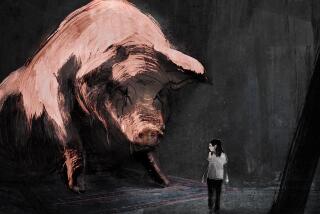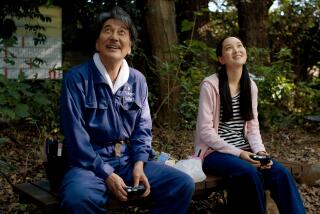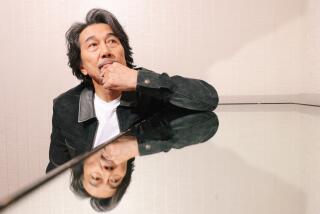Review: ‘Only Yesterday,’ a classic in Japanese animation, is a delicate beauty

Kenneth Turan reviews ‘Only Yesterday,’ a 25-year-old animated Japanese movie newly dubbed into English.
Intimate and somehow magical, “Only Yesterday” is a classic of Japanese animation, made 25 years ago but never before released in this country. To see it now is to understand the reason for the delay and why the wait has been very much worth it.
Certainly, “Only Yesterday’s” pedigree couldn’t be more impressive. Its director, Isao Takahata, is one of Japan’s great animators, most recently responsible for 2013’s Oscar-nominated “The Tale of the Princess Kaguya.”
In 1985, Takahata joined with Japan’s fantasy animation master Hayao Miyazaki (“My Neighbor Totoro,” “Spirited Away”) to co-found the legendary Studio Ghibli. Both men share a preference for intrepid girls as protagonists but, in this film at least, Takahata finds the emotional complications of the everyday more alluring than any fantasy world.
SIGN UP for the free Indie Focus movies newsletter >>
The story of a young woman who moves back and forth between childhood memories and the dilemmas of her current life, “Only Yesterday” is a realistic, personal story made universal in a delicate way.
Although it might have baffled American audiences back in 1991, when Disney’s considerably more rousing “Beauty and the Beast” ruled the roost, “Only Yesterday’s” ability to find the beauty and allure in ordinary experience could well strike a chord today.
Screening in subtitled and dubbed versions, “Only Yesterday” is based on a Japanese graphic novel and, especially in its childhood scenes, has very much the flavor of remembered experience. It begins in the Tokyo of 1982, where a 27-year-old office worker is about to begin a vacation. No, she tells her supervisor, she’s not going abroad, she’s going to spend time on a farm in the country.
This would be Taeko (“Star Wars: The Force Awakens’” Daisy Ridley in the dubbed version, Miki Imai in the original). Unmarried and having just turned down a suitor, she feels a bit at loose ends and has always wished she lived in the country.
So Taeko makes arrangements to visit the farm of her brother-in-law’s family where she’s worked before, this time to pick safflowers, plants whose vivid red petals are traditionally used to make rouge.
Because yearning for the countryside connects Taeko with her childhood, first thinking about the trip and then actually riding on the train to her destination trigger recollections of what life was like for her 10-year-old, fifth-grade self. (Voiced by Alison Fernandez in the English dub, Youko Honna in the original.)
The youngest person in a household that includes a somber father, a worried mother, two older sisters and a distant grandmother, Taeko has all kinds of memories of her childhood, from the first pineapple the family tried (they can’t figure out how to eat it) to a pitched battle with a sister over a coveted enamel purse.
Even more intense emotions come into play at school, where Taeko has to cope with boys who relentlessly tease the girls about menstruation as well as her first serious, almost wordless crush on a popular, baseball-playing classmate.
When the two manage to successfully exchange a few words, Taeko’s emotions soar and the film, which has more of a watercolor look in these sequences than in the more vivid present day, wonderfully captures that feeling by showing her literally floating on air.
Frustrated as well as warmed by these memories (“It’s like traveling with a 10-year-old” she grouses to herself) the adult Taeko, with a job she neither loves nor hates, starts to wonder if she has been true to her more adventurous younger self.
Complicating these thoughts is the presence of a handsome young organic farmer named Toshio (“Slumdog Millionaire’s” Dev Patel and Toshio Yanagiba), whose enthusiasm for his work acts as a tonic. “It’s fascinating to raise living things,” he tells her. “If you take care of them, they’ll do the best for us.” He also shrewdly observes that when city people say they love nature, they are invariably talking about landscapes that have been created by man.
A film with a mind of its own, “Only Yesterday” finds time to go into detail about the history and harvesting of safflower plants, but mostly it focuses on Taeko’s emotions as she struggles to make peace between her childhood and her current situation.
Considered a landmark in Japanese animation for the realism of its drama, “Only Yesterday’s” emphasis on the rhythms and events of the everyday means its style takes a bit of getting used to. But once you get on this film’s wavelength, it has you for the duration.
------------
‘Only Yesterday’
No MPAA rating
Running time: 1 hour, 59 minutes
Playing: Landmark’s Nuart, West Los Angeles
More to Read
Only good movies
Get the Indie Focus newsletter, Mark Olsen's weekly guide to the world of cinema.
You may occasionally receive promotional content from the Los Angeles Times.








